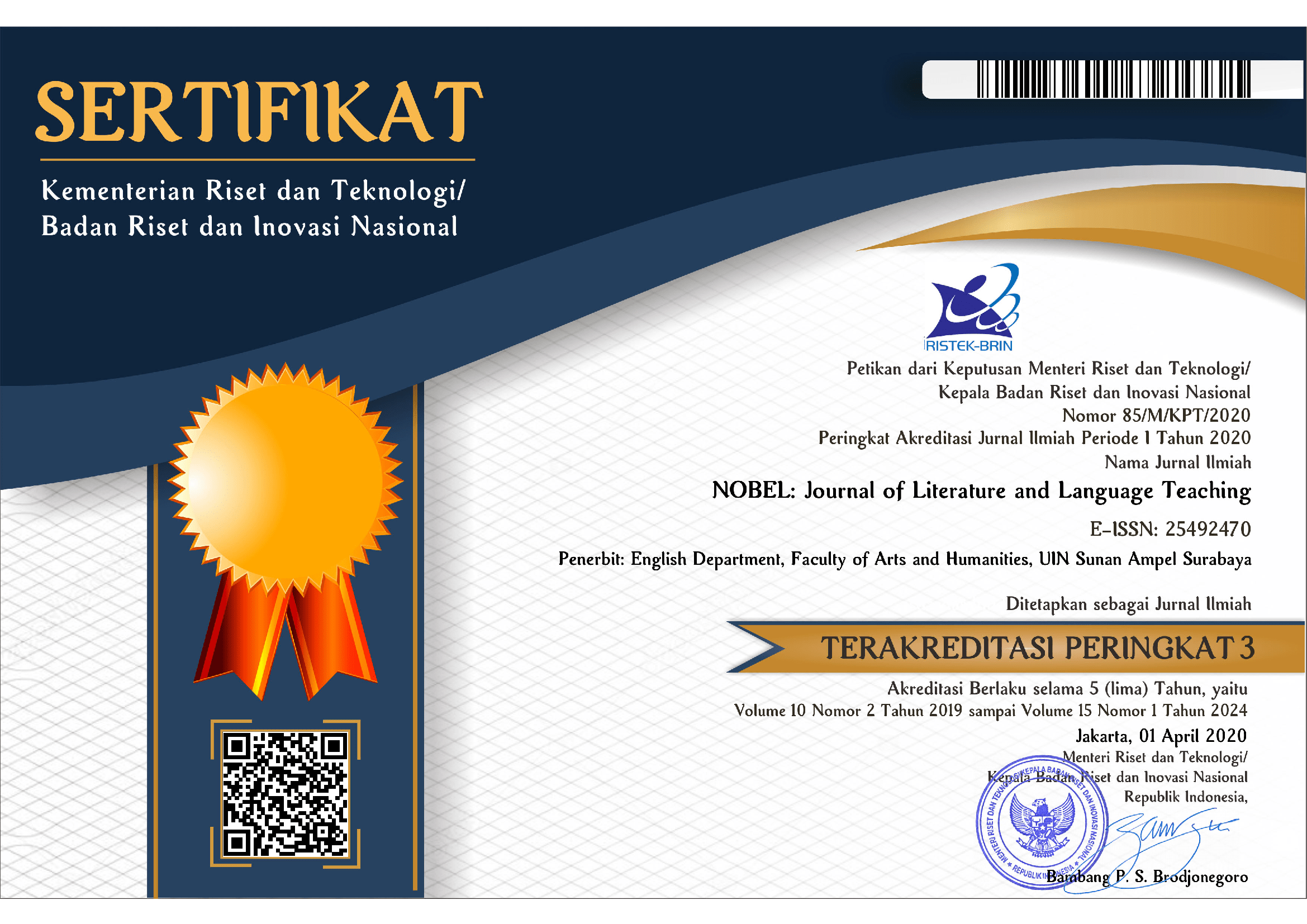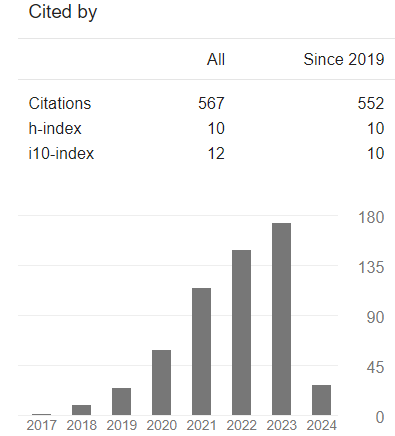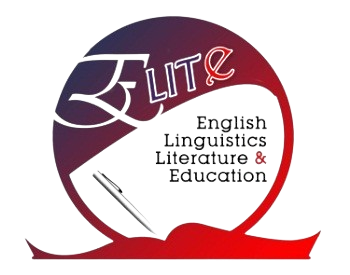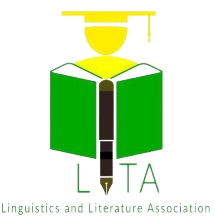A Cultural Content Analysis of the EFL Textbook for Primary Education in Indonesia
DOI:
https://doi.org/10.15642/NOBEL.2022.13.1.67-82Keywords:
cultural content analysis; English textbook; aspect of culture; dimensions of cultureAbstract
This study attempts to investigate the cultural contents of two EFL textbooks entitled English for Elementary School Students Grade 6 and Grow with English Book 6. This research is qualitative descriptive research, particularly content analysis. This study uses the categorization of cultural aspects by Cortazzi and Jin (1999), including source culture, target culture, and International culture. Adaskou’s et al. (1990) categorization of cultural dimensions covering sociological sense, aesthetic sense, semantic sense, and pragmatic sense is also employed. The findings show that the two English textbooks present the cultural aspects and dimensions differently. English for Elementary School Students Grade 6 textbook carries out more source culture than target culture and international culture. In comparison, Grow with English Grade 6 textbook carries out more target culture than source and global cultures. The findings also reveal that the sociological sense is the most prominent sense occurring in the two textbooks compared to the aesthetic, semantic, and pragmatic senses. Therefore, from the results, it can be inferred that the proportion of the cultural content in the two textbooks is imbalanced.
Downloads
References
Adaskou, K., Britten, D., & Fahsi, B. (1990). Design decisions on the cultural content of a secondary English course for Morocco. ELT Journal, 44(1), 3–10. https://doi.org/https://doi.org/10.1093/elt/44.1.3
Al-Sofi, B. B. M. (2018). An evaluation of the cultural aspects in the university English textbook, Well Read 1. Theory and Practice in Language Studies, 8(2), 184. https://doi.org/10.17507/tpls.0802.02
Amara, M. (2017). The representation of cultural elements in English-language textbooks in Israel: Implications for Arab students. Israel Studies in Language and Society, 10(1), 101–128. http://www.chaimnoy.com/Articles/ArticleKatrielReview10-2017IsraelStudiesLanguageSociety.pdf#page=101
Arslan, S. (2016). An analysis of two Turkish EFL books in terms of cultural aspects. Procedia - Social and Behavioral Sciences, 232(10), 217–225. https://doi.org/10.1016/j.sbspro.2016.10.049
Brown, H. D. (2007). Teaching by principles: An interactive approach to language pedagogy. Pearson education.
Cortazzi, M., & Jin, L. (1999). Cultural mirrors: Materials and methods in the EFL classroom. In E. Hinkel (Ed.), Culture in Second Language Teaching and Learning (pp. 196–220). Cambridge University Press.
Faris, I. N. I. (2014). Cultural content analysis of an English textbook for senior high school grade three in Cianjur, West Java. Journal of English and Education, 2(2), 14–25. https://web.archive.org/web/20180509184635id_/http://ejournal.upi.edu/index.php/L-E/article/viewFile/4599/3200
Frankel, J., Parsley, D., & Wei, S. J. (2012). Slow pass-through around the world: A new import for developing countries? Open Economies Review, 23(2), 213–251. https://doi.org/10.1007/S11079-011-9210-8/TABLES/11
Gunantar, D. A. (2017). Textbooks analysis: Analyzing English as a foreign language (EFL) textbooks from the perspective of Indonesian culture. Language Circle: Journal of Language and Literature, 11(2), 173–182. https://doi.org/10.15294/lc.v11i2.9590
Hermawan, B., & Noerkhasanah, L. (2012). Traces of cultures in English textbook for primary education. CONAPLIN JOURNAL Indonesian Journal of Applied Linguistics, 1(2), 49–61. http://jurnal.upi.edu/file/Budi_Hermawan_final_49-61.pdf
Khodadady, E., & Shayesteh, S. (2016). Cultural and linguistic imperialism and the EIL movement: Evidence from a textbook analysis. Educational Research, 26(4), 604–622. https://eric.ed.gov/?id=EJ1117989
Krippendorff, K. (2004). Reliability in content analysis. Human Communication Research, 30(3), 411–433. https://doi.org/10.1111/J.1468-2958.2004.TB00738.X
Liddicoat, A., & Crozet, C. (1997). Teaching culture as an integrated part of language teaching: an introduction. Australian Review of Applied Linguistics, Series S(14), 1–22. https://search.informit.org/doi/abs/10.3316/ielapa.980808181
Liddicoat, A. J. (2004). Intercultural language teaching: principles for practice. New Zealand Language Teacher, 30(2004), 17–24. https://www.researchgate.net/profile/Anthony-Liddicoat-2/publication/281571069_Intercultural_language_teaching_principles_for_practice/links/5bc7152fa6fdcc03c7899754/Intercultural-language-teaching-principles-for-practice.pdf
Liddicoat, A. J., & Crozet, C. (Eds.). (2000). Teaching languages, teaching cultures. Language Australia. https://eric.ed.gov/?id=ED471407
Lund, A. (2006). The multiple contexts of online language teaching. Language Teaching Research, 10(2), 181–204. https://doi.org/10.1191/1362168806LR191OA
Mckay, S. L. (2000). Teaching English as an international language: Implications for cultural materials in the classroom. TESOL Journal, 9(4), 7–11. https://eric.ed.gov/?id=EJ621483
Moran, P. R. (2001). Teaching culture: Perspectives in practice. Heinle & Heinle.
Mukarto, F. X. (2017). Grow with English: A thematic English course for elementary students Book 6. Penerbit Erlangga.
Nashriyah, N., Maulida, R., Ningsih, Y. S., & Yusuf, Y. Q. (2020). Addressing gender bias issues in elementary school EFL textbooks: An analysis of grow with English. Humanities & Social Sciences Reviews, 8(3), 56–63. https://doi.org/10.18510/hssr.2020.837
Nurjanah, I., & Umaemah, A. (2019). An analysis of cultural content in the textbook “Pathway to English” for second grade in senior high school. ELT-Echo, 4(1), 83–92. https://doi.org/http://dx.doi.org/10.24235/eltecho.v4i1.4536
Rachmawati, I. (2020). Language and culture in multicultural society of English language course. NOBEL: Journal of Literature and Language Teaching, 11(1), 55–68. https://doi.org/10.15642/nobel.2020.11.1.55-68
Radić-Bojanić, B. B., & Topalov, J. P. (2016). Textbooks in the EFL classroom: Defining, assessing and analyzing. Collection of Papers of the Faculty of Philosophy in Priština, 46(3), 137–153. https://doi.org/10.5937/ZRFFP46-12094
Ratri, D. P., & Puspitasari, I. (2019). Need analysis for developing course book for English for elementary school students with local-content values. IJEE (Indonesian Journal of English Education), 6(1), 1–9. https://doi.org/10.15408/ijee.v6i1.9908
Razavi, M., & Gilakjani, A. P. (2020). The effect of teaching cultural content on intermediate EFL learners’ reading comprehension ability. Teflin Journal, 31(2), 302–321. https://doi.org/10.15639/teflinjournal.v31i2/302-321
Schreiber, J., & Asner-Self, K. (2011). Educational research: the interrelationship of questions, sampling, design, and analysis. Wiley.
Songbatumis, A. M. (2017). Challenges in teaching English faced by English teachers at MTsN Taliwang, Indonesia. Journal of Foreign Language Teaching and Learning, 2(2), 54–67. https://doi.org/10.18196/ftl.2223
Suryarini, D. Y. (2019). Evaluasi buku teks bahasa Inggris "Stairway: A fun and easy English book” grade VI elementary school. Trapsila: Jurnal Pendidikan Dasar, 1(2), 33–46. https://doi.org/http://dx.doi.org/10.30742/tpd.v1i02.811
Sya, M. F., & Helmanto, F. (2020). Pemerataan pembelajaran muatan lokal bahasa Inggris sekolah dasar Indonesia. DIDAKTIKA TAUHIDI: Jurnal Pendidikan Guru Sekolah Dasar, 7(1), 71–81. https://doi.org/10.30997/dt.v7i1.2348
Tim Masmedia Buana Pustaka. (2020). English for elementary school students Grade 6. Masmedia Buana Pustaka.
Wu, J. (2010). A content analysis of the cultural content in the EFL textbooks. Canadian Social Science, 6(5), 137–144. https://doi.org/http://dx.doi.org/10.3968/j.css.1923669720100605.016
Zarei, G. R., & Khalessi, M. (2011). Cultural load in English language textbooks: An analysis of interchange series. Procedia - Social and Behavioral Sciences, 15(June), 294–301. https://doi.org/10.1016/j.sbspro.2011.03.089
Downloads
Published
How to Cite
Issue
Section
License
Copyright (c) 2022 NOBEL: Journal of Literature and Language Teaching

This work is licensed under a Creative Commons Attribution 4.0 International License.







